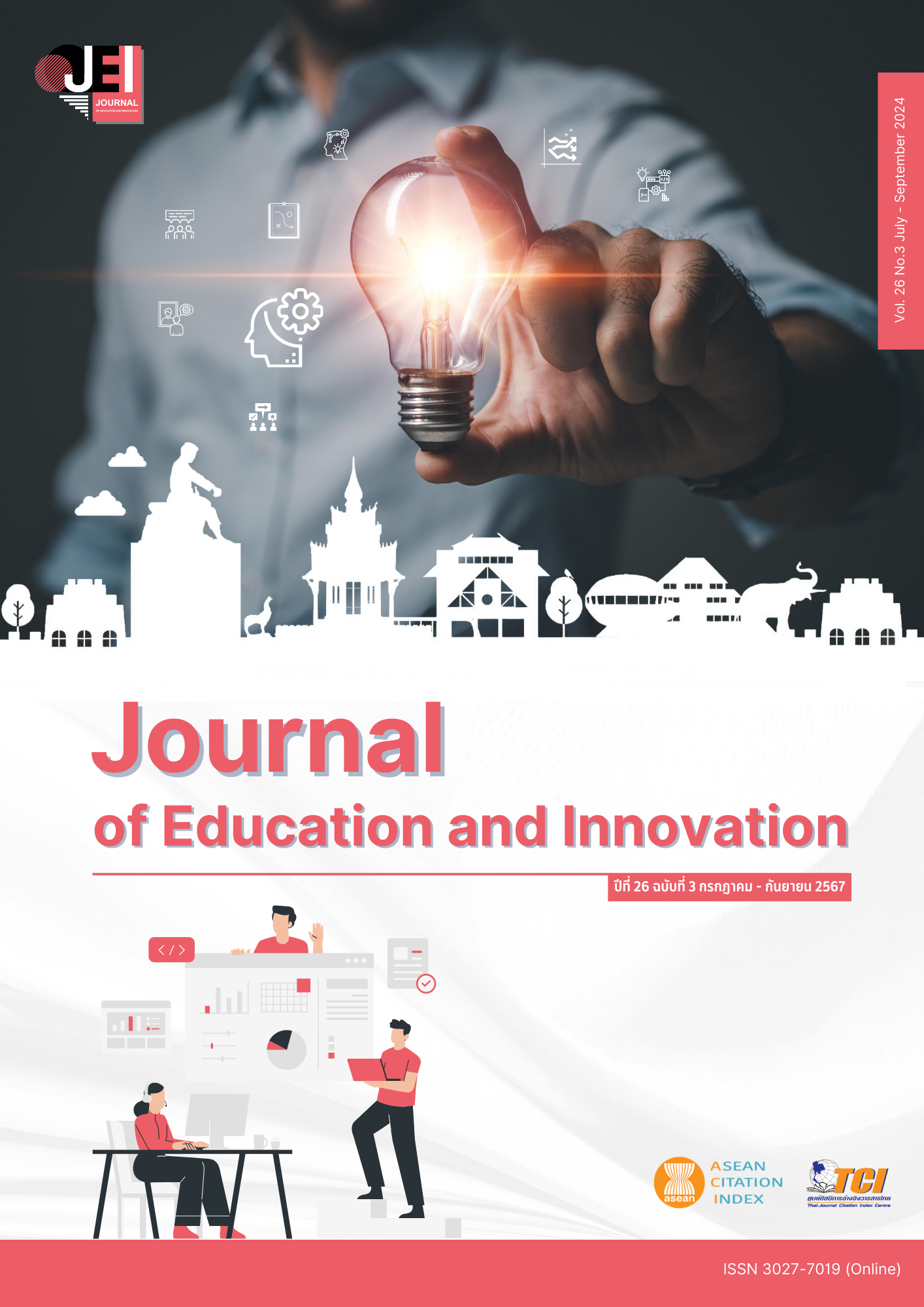เทคนิคการใช้เรื่องเล่าดิจิทัลสำหรับสอนอย่างสร้างสรรค์เพื่อส่งเสริมทักษะการออกแบบฉลากผลิตภัณฑ์ท้องถิ่น ในการยกระดับรายได้ครัวเรือน ตำบลสบปราบ จังหวัดลำปาง
Main Article Content
บทคัดย่อ
การวิจัยครั้งนี้มีวัตถุประสงค์เพื่อ 1) พัฒนาเรื่องเล่าดิจิทัลสำหรับสอนอย่างสร้างสรรค์ เพื่อส่งเสริมทักษะการออกแบบฉลากผลิตภัณฑ์ท้องถิ่น 2) เปรียบเทียบทักษะการออกแบบฉลากผลิตภัณฑ์ท้องถิ่นหลังเรียนด้วยชุดเรื่องเล่าดิจิทัลกับเกณฑ์ร้อยละ 80 และ 3) ศึกษาองค์ประกอบของเรื่องเล่าดิจิทัลที่ส่งผลกระทบต่อทักษะการออกแบบฉลากผลิตภัณฑ์ท้องถิ่น กลุ่มตัวอย่างเป็นผู้ผลิตกล้วยฉาบในตำบลสบปราบ จำนวน 20 คน เลือกมาโดยสมัครใจ แผนการทดลองแบบกลุ่มเดียววัดผลหลังการทดลอง One-Shot Case Design เครื่องมือที่ใช้ ได้แก่
ชุดเรื่องเล่าดิจิทัล แบบสำรวจประชากรศาสตร์ แบบสัมภาษณ์ แบบสอบถามความคิดเห็น แบบทดสอบวัดทักษะการออกแบบฉลากผลิตภัณฑ์ วิเคราะห์ข้อมูลโดยใช้สถิติ ร้อยละ ค่าเฉลี่ย ส่วนเบี่ยงเบนมาตรฐาน ผลการวิจัยได้ดังนี้
1. การพัฒนาสื่อเรื่องเล่าดิจิทัลสำหรับสอนอย่างสร้างสรรค์ เพื่อส่งเสริมทักษะการออกแบบฉลากผลิตภัณฑ์ท้องถิ่น ทำให้ได้ “ชุดเรื่องเล่าดิจิทัล สร้างสรรค์ฉลากผลิตภัณฑ์” ประกอบด้วย 3 เรื่อง คือ รวบตึง, จุกจุก, สุดปัง ดำเนินเรื่องแบบตลกขบขันในการให้ความรู้ โดยมีคุณภาพความในระดับมาก ค่าเฉลี่ยเท่ากับ 4.41 มีค่าประสิทธิภาพ 72.22/70.56 ตามเกณฑ์ที่กำหนด
2. การเปรียบเทียบทักษะการออกแบบฉลากผลิตภัณฑ์กับเกณฑ์ร้อยละ 80 พบว่า หลังเรียนกลุ่มเป้าหมายมีคะแนนเฉลี่ยเท่ากับ 33.50 คิดเป็นร้อยละ 83.75 สูงกว่าเกณฑ์อย่างมีนัยสำคัญทางสถิติระดับ .01
3. องค์ประกอบของเรื่องเล่าดิจิทัลที่ส่งผลกระทบต่อทักษะการออกแบบฉลากผลิตภัณฑ์ท้องถิ่น สามารถแบ่งออกได้เป็น 2 ประเภทหลัก ดังนี้ 1) องค์ประกอบด้านเนื้อหา ได้แก่ ความน่าสนใจ ความยาวของการนำเสนอ ความเชื่อมโยง ความท้าทาย และความสร้างสรรค์ 2) องค์ประกอบด้านสื่อดิจิทัล ได้แก่ การใช้เทคโนโลยีที่เหมาะสม การออกแบบที่มีประสิทธิภาพ การนำเสนอที่ประณีต
Article Details

อนุญาตภายใต้เงื่อนไข Creative Commons Attribution-NonCommercial-NoDerivatives 4.0 International License.
เจ้าของบทความมิได้คัดลอก หรือละเมิดลิขสิทธิ์ของผู้ใด หากเกิดการละเมิดลิขสิทธิ์ ไม่ว่าวิธีใด หรือการฟ้องร้องไม่ว่ากรณีใด ๆ ที่อาจเกิดขึ้นได้ กองบรรณาธิการวารสารศึกษาศาสตร์ ไม่มีส่วนเกี่ยวข้องทั้งสิ้น ให้เป็นสิทธิ์ของเจ้าของบทความที่จะดำเนินการ
เอกสารอ้างอิง
Abderrahim, L., & Gutiérrez-Colón Plana, M. (2021). A theoretical journey from social constructivism to digital storytelling. The EUROCALL Review, 29(1), 38-49.
Christian, F., & Klaus, U. (2021). The public service media and public service internet manifesto. London: University of Westminster Press.
Chuaychoocherd, N. (2020). The effect of online lessons by inquiry-based learning with Moodle for Matthayomsuksa 6 students. E-Journal of Media Innovation and Creative Education, Srinakharinwirot University, 3(2), 52-64.
Jonassen, D. H. (2003). Learning with technology: A constructivist perspective. New York: Pearson Education.
Khammani, T. (2018). The Science of Teaching: Knowledge for Effective Learning Processes. Bangkok: Chulalongkorn University Press.
Nakhon, T. (2019). Development of learning activities simulations with multimedia on English for daily life for Matthayomsuksa 5 students, foreign language department. Journal of Educational Technology and Communications Faculty of Education Mahasarakham University, 2(6), 106-118.
Office of the National Economic and Social Development Council. (2022). The National Economic and Social Development Plan 2023-2027 (study report). Bangkok: Office of the National Economic and Social Development Council.
Özüdoğru, G. (2021). Digital storytelling in education from teachers’ perspectives. Journal of Faculty of Education Bartın University, 10(2), 445-454.
Pariyawatid, P., & Napapongs, W. (2016). Effecting augmented reality code of Chinese vocabularies lesson for grade 3 students at Tessaban 2 Wattaninarasamosorn School. Academic Services Journal Prince of Songkla University, 27(1), 9-17.
Phuchin, R., & Umkrai, J. (2016). Development of computer-assisted learning lessons with three-dimensional augmented reality techniques in science for grade 4 students. National Conference on Technology and Innovation Management, 2nd Conference, Nakhon Pathom Rajabhat University (pp. 4-18). Nakhon Pathom: Nakhon Pathom Rajabhat University.
Spee, J. C., & McCormick, D, W. (2012). The design ethos of Dieter Rams and its implications for organizations and management education. Academy of Management Annual Meeting Proceedings, 4(1), 29-38.
Sripatthanaphanlert, R., Biko, R., & Maithong, W. (2021). Learning material by augmented reality about the solar system for grade 4. Udonthani Rajabhat University Journal of GURU Education, 3(1), 51-61.
Srisa-ard, B. (1989). Statistical methods for researchers, volume 2. Bangkok: Charoenphol Printing.
Susaoraj, P. (2013). Development of thinking (5th ed.). Bangkok: 9119 Technic Printing.
Suttirat, C. (2018). 80 Innovations in learner-centered learning (8th ed.). Nonthaburi: P Balance Design and Printing.
The Office of National Higher Education Science Research and Innovation Policy Council. (2021). Promoting the Lifelong learning to respond to sudden changes and global crises. Bangkok: The Office of National Higher Education Science Research and Innovation Policy Council (NXPO).
Wongratana, C. (2007). Techniques for using statistics for research (10th ed.). Bangkok: Srinakharinwirot University.


